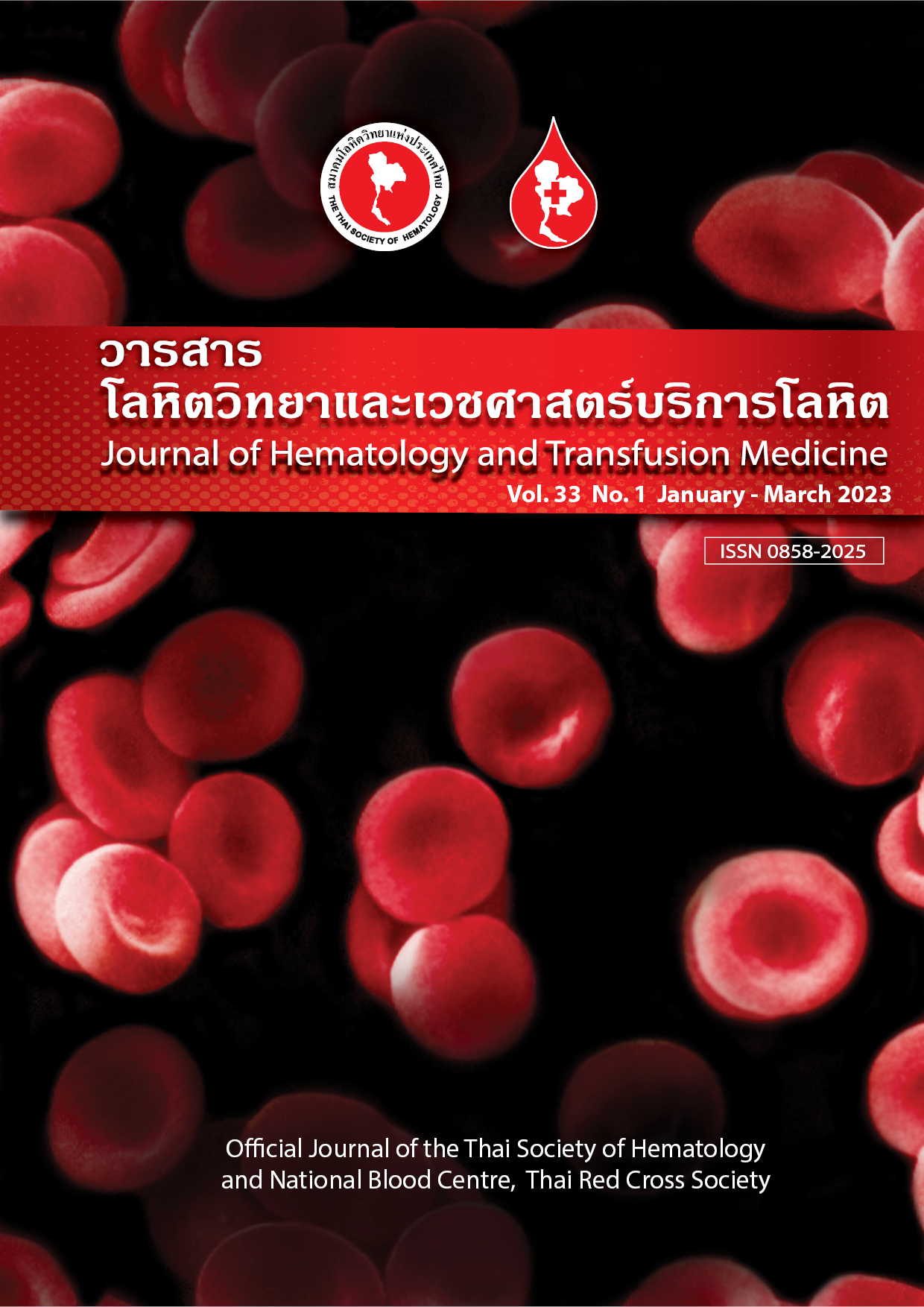การทดสอบแอนติเจน C, E, c, e และ Mia บนเม็ดเลือดแดง โดยใช้เครื่องตรวจวิเคราะห์อัตโนมัติ Ortho Vision Max ในผู้บริจาคโลหิตของภาคบริการโลหิตแห่งชาติที่ 3 จังหวัดชลบุรี
Keywords:
การตรวจแอนติเจนบนเม็ดโลหิตแดง, ความถี่ของแอนติเจนระบบ Rh และ Mia, Red cell phenotype, Automated phenotyping, Prevalence of Rh anf Mia phenotypes, การตรวจแอนติเจนด้วยเครื่องตรวจวิเคราะห์อัตโนมัติAbstract
บทคัดย่อ
บทนำ แอนติเจน C, E, c, e และ Mia จัดเป็นแอนติเจนที่สำคัญทางคลินิก ซึ่งพบว่าผู้ป่วยจะสร้างแอนติบอดีต่อแอนติเจนเหล่านี้ได้บ่อยในคนไทย สามารถทำให้เกิด hemolytic transfusion reaction และ hemolytic disease of the fetus and newborn ได้ วัตถุประสงค์ เพื่อทดสอบการใช้น้ำยาของศูนย์บริการโลหิตแห่งชาติ สภากาชาดไทย และบริษัทต่างๆ ในการทดสอบแอนติเจน C, E, c, e และ Mia ในผู้บริจาคโลหิตของภาคบริการโลหิตแห่งชาติที่ 3 จังหวัดชลบุรี เพื่อช่วยในการลดค่าใช้จ่าย วัสดุและวิธีการ ทดสอบหา dilution ของแอนติซีรัมในการทดสอบแอนติเจนบนเม็ดเลือดแดง C, E, c, e และ Mia โดยใช้น้ำยาของศูนย์บริการโลหิตแห่งชาติ สภากาชาดไทย และของบริษัท Ortho Clinical Diagnostic, Switzerland ทำการทดสอบด้วยเครื่องตรวจวิเคราะห์อัตโนมัติ Ortho Vision Max และวิเคราะห์ความถี่ของแอนติเจนที่ตรวจตั้งแต่เดือนมกราคม พ.ศ. 2564 ถึงกันยายน พ.ศ. 2565 จำนวน 8,565 ราย ผลการศึกษา น้ำยาแอนติซีรัมของศูนย์บริการโลหิตแห่งชาติ สภากาชาดไทย และของบริษัท Ortho Clinical Diagnostic สามารถเจือจางเพื่อใช้ทดสอบแอนติเจน C, E, c, e และ Mia ด้วยเครื่องตรวจวิเคราะห์อัตโนมัติ Ortho Vision Max และให้ผลได้ถูกต้อง สามารถประหยัดต้นทุนในการทดสอบได้ 3 เท่า นอกจากนี้ การศึกษาในผู้บริจาคโลหิต จำนวน 8,565 ราย พบฟีโนไทป์ในระบบ Rh ชนิด (C+E-c-e+) ร้อยละ 56.53, (C+E-c+e+) ร้อยละ 8.93, (C+E+c+e+) ร้อยละ 24.45, (C+E+c-e+) ร้อยละ 3.71, (C-E+c+e-) ร้อยละ 2.80, (C-E+c+e+) ร้อยละ 2.16, (C+E+c+e-) ร้อยละ 0.63, (C-E-c+e+) ร้อยละ 0.62 และ (C+E+c-e-) ร้อยละ 0.16 รวมทั้งพบ Mi(a+) และ Mi(a-) ร้อยละ 12.98, 87.02 ตามลำดับ สรุป การใช้น้ำยาของศูนย์บริการโลหิตแห่งชาติ สภากาชาดไทย ในการทดสอบแอนติเจนด้วยเครื่องตรวจวิเคราะห์อัตโนมัติพบว่าให้ผลถูกต้องทำให้สามารถลดต้นทุนการทดสอบได้มาก ภายใต้การเฝ้าระวังอย่างต่อเนื่อง ทั้งนี้ ฟีโนไทป์ในระบบ Rh และแอนติเจน Mia ในภูมิภาคตะวันออกสอดคล้องกับความถี่ของแอนติเจนในคนไทยภาคกลางที่เคยศึกษามาก่อนหน้านี้
Abstract:
Introduction: C, E, c, e and Mia antigens on red cells are clinically significant in Thai population which cause hemolytic transfusion reaction and hemolytic disease of fetus and newborn. Objective: To optimize C, E, c, e and Mia phenotyping using automated analyzer to reduce expenses at Regional Blood Centre III, Chonburi province. Materials and Methods: C, E, c, e and Mia phenotyping was performed using titrated reagents produced from National Blood Centre, Thai Red Cross Society and Ortho Clinical Diagnostic, Switzerland on Ortho Vision Max analyzer and the prevalence of antigen C, E, c, e and Miain the eastern part of Thailand was assessed. Results: Our study showed that reagents produced from National Blood Centre, Thai Red Cross Society and Ortho Clinical Diagnostic can be diluted with a decrease in expenses per test using Ortho Vision Max, whereas, the accuracy of the results of phenotyping was not affected. Among 8,565 blood donors the prevalence of RhCE phenotypes were observed as follows: 56.53% of (C+E-c-e+), 8.93% of (C+E-c+e+), 24.45% of (C+E+c+e+), 3.71% of (C+E+c-e+), 2.80% of (C-E+c+e-), 2.16% of (C-E+c+e+), 0.63% of (C+E+c+e-), 0.62% of (C-E-c+e+) and 0.16% of (C+E+c-e-). The prevalences of Mi(a+) and Mi(a-) were 12.98% and 87.02%, respectively. Conclusion: Under careful monitoring, using reagents produced from National Blood Centre, Thai Red Cross Society and company potentially decreases expenses of phenotyping. The prevalence of C, E, c, e and Mia phenotypes in the east part of Thailand are in accordance with previous study in which the prevalences of those phenotypes were evaluated in central Thailand.
Downloads
References
Avent ND, Reid ME. The Rh blood group system: a review. Blood. 2000;95:2197.
Westhoff C.M. The Rh blood group system in review: A new face for the next decade. Transfusion. 2004;44:1663-73.
Red cell immunogenetics and Blood Group Terminology Working Party[internet], The International Society of Blood Transfusion; 2022 [updated 2022 Dec 31; cited 2022 Jan 10]. Available from: http://www.isbtweb.org.
Reid ME, Lomas-Francis C, Olsson ML. The blood group antigen: FactsBook. 3rd ed. Boston: Academic Press; 2012.
Palacajornsuk P. Review: molecular basis of MNS blood group variants. Immunohematology. 2006;22:171-82.
Wei L, Lopez GH, Zhang Y, Wen J, Wang Z, Fu Y et al. Genotyping analysis of MNS blood group GP(B-A-B) hybrid glycophorins in the Chinese Southern Han population using a high-resolution melting assay. Transfusion. 2018;58:1763-71.
Huynh NT, Ford DS, Duyen TT, Huong MT. Jk and Mi.III phenotype frequencies in North Vietnam. Immunohematology. 2003;19:57-8.
Hsu K, Lin YC, Chao HP, Lee TY, Lin M, Chan YS. Assessing the frequencies of GP.Mur (Mi.III) in several Southeast Asian populations by PCR typing. Transfus Apher Sci. 2013;49:370-1.
Sinkitjasub A, Surakamolert V, Chanta P. The prevalence of unexpected antibodies in pregnant women attending antenatal care (ANC) of Taksin Hospital. J Hematol Transfus Med. 2011;21:153-8.
Rattakul A, Intharanut K, Nathalang O. The prevalence of red cell antibodies among patients and pregnant women in Pakchongnana Hospital. J HematolTransfus Med. 2019;29:317-24.
Thangtrakul P, Buathong D, Yeela T, Pengsakul T. Prevalence of unexpected maternal antibodies
at delivery in Songklanagarind Hospital. Journal of the Department of Medical Services. 2020;62:114-22
Fongsarun J, Nuchprayoon I, Yod-in S, Kupatawintu P, Kidprasirt C. Blood groups in Thai blood donors. J Hematol Transfus Med. 2002;12:277-86.
Department of Medical Services. Guidelines for the care of thalassemia patients in general practice; 2017. p. 41-2.
Tormey CA, Hendrickson JE. Transfusion-related red blood cell alloantibodies: induction and consequences. Blood. 2019;133:1821-30.
Kupatawintu P, Emthip M, Sungnoon D, O-vataga P, Manakul V, Limtamaporn S. et al. Unexpected antibodies of patients, blood samples sent for testing at NBC, TRCS. J Hematol Transfus Med, 2010;20:255-62.
U.S. Department of Health and Human Services Food and Drug Administration Center for Biologics Evaluation and Research. Labeling of red blood cell units with historical antigen typing results; 2018.
Downloads
Published
Issue
Section
License
Copyright (c) 2023 Journal of Hematology and Transfusion Medicine

This work is licensed under a Creative Commons Attribution-NonCommercial-NoDerivatives 4.0 International License.



